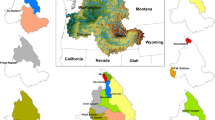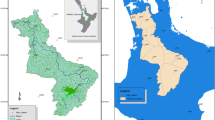Abstract
Uncertainties in climate modelling are well documented in literature. Global Climate Models (GCMs) are often used to downscale the climatic parameters on a regional scale. In the present work, we have analyzed the changes in precipitation and temperature for future scenario period of 2070–2099 with respect to historical period of 1970–2000 from statistically downscaled GCM projections in Columbia River Basin (CRB). Analysis is performed using two different statistically downscaled climate projections (with ten GCMs downscaled products each, for RCP 4.5 and RCP 8.5, from CMIP5 dataset) namely, those from the Bias Correction and Spatial Downscaling (BCSD) technique generated at Portland State University and from the Multivariate Adaptive Constructed Analogs (MACA) technique, generated at University of Idaho, totaling to 40 different scenarios. The two datasets for BCSD and MACA are downscaled from observed data for both scenarios projections i.e. RCP4.5 and RCP8.5. Analysis is performed using spatial change (yearly scale), temporal change (monthly scale), percentile change (seasonal scale), quantile change (yearly scale), and wavelet analysis (yearly scale) in the future period from the historical period, respectively, at a scale of 1/16th of degree for entire CRB region. Results have indicated in varied degree of spatial change pattern for the entire Columbia River Basin, especially western part of the basin. At temporal scales, winter precipitation has higher variability than summer and vice versa for temperature. Most of the models have indicated considerate positive change in quantiles and percentiles for both precipitation and temperature. Wavelet analysis provided insights into possible explanation to changes in precipitation.









Similar content being viewed by others
References
Abatzoglou JT, Barbero R (2014) Observed and projected changes in absolute temperature records across the contiguous United States. Geophys Res Lett 41:6501–6508. doi:10.1002/2014GL061441
Abatzoglou JT, Brown TJ (2012) A comparison of statistical downscaling methods suited for wildfire applications. Int J Climatol. doi:10.1002/joc.2312
Ahmadalipour A, Rana A, Moradkhani H (in review) Statistical multi-criteria analysis of CMIP5 GCMs for climate change impact analysis over the Columbia River Basin. Theor Appl Climatol
Barnett TP, Pierce DW, Hidalgo HG, Bonfils C et al (2008) Human induced changes in the hydrology of the western United States. Science 319:1080–1083
Bentz BJ, Régnière J, Fettig CJ, Hansen EM, Hayes JL, Hicke JA, Kelsey RG, Negrón JF, Seybold SJ (2010) Climate change and bark beetles of the western United States and Canada: direct and indirect effects. Bioscience 60:602–613
Bergstrom S (2001) Climate change impacts on runoff in Sweden-assessments by Global Climate Models, dynamical downscaling and hydrological modelling. Clim Res 16(2):101
Bonfils C, Santer BD, Pierce DW, Hidalgo HG, Bala G, Das T, Barnett TP, Cayan DR, Doutriaux C, Wood AW, Mirin A, Nozawa T (2008) Detection and attribution of temperature changes in the mountainous western United States. J Clim 21:6404–6424
Das T, Hidalgo H, Cayan DR, Dettinger MD, Pierce DW, Bonfils C, Barnett TP, Bala G, Mirin A (2009) Structure and origins of trends in hydrological measures over the western United States. J Hydrometeorol 10:871–892. doi:10.1175/2009JHM1095.1
Feng S, Hub Q, Huang W, Ho CH, Li R, Tang Z (2014) Projected climate regime shift under future global warming from multi-model, multi-scenario CMIP5 simulations. Glob Planet Change 112:41–52
Fowler HJ, Blenkinsop S, Tebaldi C (2007) Linking climate change modelling to impacts studies: recent advances in downscaling techniques for hydrological modelling. Int J Climatol 27(12):1547–1578
Halmstad A, Najafi MR, Moradkhani H (2012) Analysis of precipitation extremes with the assessment of regional climate models over the Willamette River Basin-US. Hydrol Process 27:2579–2590. doi:10.1002/hyp.937
Hansen AJ, Piekielek N, Davis C, Hass J, Theobald DM, Gross JE, Monahan WB, Olliff T, Running SW (2014) Exposure of US National Parks to land use and climate change 1900–2100. Ecol Appl 24:484–502
Hidalgo HG, Das T, Dettinger MD, Cayan DR, Pierce DW et al (2009) Detection and attribution of streamflow timing changes to climate change in the Western United States. J Clim 22:3838–3855
Jomelli V, Brunstein D, Déqué M, Vrac M, Grancher D (2009) Impacts of future climatic change (2070–2099) on the potential occurrence of debris flows: a case study in the Massif des Ecrins (French Alps). Clim Change 97:171–191
Jung I-W, Moradkhani H, Chang H (2012) Uncertainty assessment of climate change impacts for hydrologically distinct river basins. J Hydrol 466:73–87
Kharin V, Zwiers F, Zhang X, Wehner M (2013) Changes in temperature and precipitation extremes in the CMIP5 ensemble. Clim Change 119:345–357
Laifang L, Wenhong L (2014) Thermodynamic and dynamic contributions to future changes in regional precipitation variance: focus on the Southeastern United States. Clim Dyn. doi:10.1007/s00382-014-2216-3
Leung LR, Qian Y, Bian X, Washington WM, Han J, Roads JO (2004) Mid-century ensemble regional climate change scenarios for the Western United States. Clim Change 62:75–113
Liang N, Michael ME, Robert C, Thorsten W (2012) Probabilistic projections of climate change for the Mid-Atlantic Region of the United States: validation of precipitation downscaling during the historical era. J Clim 25:509–526. doi:10.1175/2011JCLI4091.1
Livneh B, Rosenberg EA, Lin C, Mishra V, Andreadis KM, Maurer EP, Lettenmaier DP (2013) Extension and spatial refinement of a long-term hydrologically based dataset of land surface fluxes and states for the conterminous United States. J Clim. doi:10.1175/JCLI-D-12-00508.1
Madadgar S, Moradkhani H (2014) Improved Bayesian multi-modeling: integration of copulas and Bayesian model averaging. Water Resour Res 50:9586–9603. doi:10.1002/2014WR015965
Maurer EP, Hidalgo HG (2008) Utility of daily vs. monthly large-scale climate data: an intercomparison of two statistical downscaling methods. Hydrol Earth Syst Sci 12:551–563. doi:10.5194/hess-12-551-2008
Moradkhani H, Baird RG, Wherry S (2010) Impact of climate change on floodplain mapping and hydrologic ecotones. J Hydrol 395:264–278
Najafi MR, Moradkhani H (2014) A hierarchical Bayesian approach for the analysis of climate change impact on runoff extremes. Hydrol Process. doi:10.1002/hyp.10113
Najafi MR, Moradkhani H (2015) Multi-model ensemble analysis of the runoff extremes for climate change impact assessments. J Hydrol. doi:10.1016/j.jhydrol.2015.03.045
Najafi MR, Moradkhani H, Wherry S (2011a) Statistical Downscaling of Precipitation using Machine Learning with Optimal Predictor Selection. J Hydrol Eng 16(8):650–664
Najafi MR, Moradkhani H, Jung I (2011b) Assessing the uncertainties of hydrologic model selection in climate change impact studies. Hydrol Process 25(18):2814–2826
Pierce DW, Barnett TP, Hidalgo HG, Das T et al (2008) Attribution of declining Western US snowpack to human effects. J Clim 21:6425–6444
Pierce DW, Das T, Cayan DR, Maurer E, Miller N, Bao Y et al (2012) Probabilistic estimates of future changes in California temperature and precipitation using statistical and dynamical downscaling. Clim Dyn 40:839–856. doi:10.1007/s00382-012-1337-9
Pinto JG, Neuhaus CP, Leckebusch GC, Reyers M, Kerschgens M (2010) Estimation of wind storm impacts over Western Germany under future climate conditions using a statistical–dynamical downscaling approach. Tellus A 62(2):188–201
Risley J, Moradkhani H, Hay L, Markstrom S (2011) Statistical trends in watershed scale response to climate change in selected basins across the United States. AMS Earth Interact 15(14):1–26
Samadi SZ, Wilson CA, Moradkhani H (2013) Uncertainty analysis of statistical downscaling models using hadley centre coupled model. J Theor Appl Climatol. doi:10.1007/s00704-013-0844-x
Schoof JT, Shin DW, Cocke S, LaRow E, Lim YK, O’Brien JJ (2009) Dynamically and statistically downscaled seasonal temperature and precipitation hindcast ensembles for the southeastern USA. Int J Climatol 29(2):243–257
Taylor KE, Stouffer RJ, Meehl GA (2012) An overview of CMIP5 and the experiment design. Bull Am Meteorol Soc 93:485–498. doi:10.1175/BAMS-D-11-00094.1
Tohver IM, Hamlet AF, Lee S (2014) Impacts of 21st-century climate change on hydrologic extreme in the Pacific Northwest Region of North America. J Am Water Resour Assoc (JAWRA). doi:10.1111/jawr.12199
Torrence C, Compo GP (1998) A practical guide to wavelet analysis. Bull Am Meteorol Soc 79:61–78
Waldhoff ST, Martinich J, Sarofim M et al (2014) Overview of the special issue: a multi-model framework to achieve consistent evaluation of climate change impacts in the United States. Clim Change 131:1–20. doi:10.1007/s10584-014-1206-0
Werner AT (2011) BCSD downscaled transient climate projections for eight select GCMs over British Columbia. Pacific Climate Impacts Consortium, University of Victoria, Victoria
Wilby RL, Hay LE, Leavesley GH (1999) A comparison of downscaled and raw GCM output: implications for climate change scenarios in the San Juan River basin, Colorado. J Hydrol 225(1–2):67–91
Wilson TS, Sleeter BM, Davis AW (2014) Potential future land use threats to California’s protected areas. Reg Environ Change 15:1051–1064. doi:10.1007/s10113-014-0686-9
Wood AW, Maurer EP, Kumar A, Lettenmaier DP (2002) Long-range experimental hydrologic forecasting for the eastern United States. J Geophys Res Atmos. doi:10.1029/2001jd000659
Wood AW, Leung LR, Sridhar V, Lettenmaier DP (2004) Hydrologic implications of dynamical and statistical approaches to downscaling climate model outputs. Clim Change 62:189–216
Wuebbles D, Meehl G, Hayhoe K, Karl TR, Kunkel K, Santer B, Wehner M, Colle B, Fischer EM, Fu R, Goodman A, Janssen E, Kharin V, Lee H, Li W, Long LN, Olsen SC, Pan Z, Seth A, Sheffield J, Sun L (2014) Cmip5 climate model analyses: climate extremes in the united states. Bull Am Meteorol Soc 95:571–583. doi:10.1175/BAMS-D-12-00172.1
Acknowledgments
Partial financial support for this study was provided by the DOE-BPA (cooperative agreement 00063182) and institute for sustainable solution at Portland State University. The authors would also like to acknowledge the World Climate Research Programme’s Working Group on Coupled Modelling, which is responsible for CMIP, and we thank the climate modeling groups for producing and making available their model outputs. For CMIP, the US Department of Energy’s Program for Climate Model Diagnosis and Intercomparison provides coordinating support and leads development of software infrastructure in partnership with the Global Organization for Earth System Science Portals.
Author information
Authors and Affiliations
Corresponding author
Electronic supplementary material
Below is the link to the electronic supplementary material.
Rights and permissions
About this article
Cite this article
Rana, A., Moradkhani, H. Spatial, temporal and frequency based climate change assessment in Columbia River Basin using multi downscaled-scenarios. Clim Dyn 47, 579–600 (2016). https://doi.org/10.1007/s00382-015-2857-x
Received:
Accepted:
Published:
Issue Date:
DOI: https://doi.org/10.1007/s00382-015-2857-x




